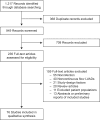Left Ventricular Assist Device Infections: A Systematic Review
- PMID: 29095732
- PMCID: PMC5920737
- DOI: 10.1097/MAT.0000000000000684
Left Ventricular Assist Device Infections: A Systematic Review
Abstract
Left ventricular assist devices (LVADs) are becoming a more frequent life-support intervention. Gaining an understanding of risk factors for infection and management strategies is important for treating these patients. We conducted a systematic review and meta-analysis of studies describing infections in continuous-flow LVADs. We evaluated incidence, risk factors, associated microorganisms, and outcomes by type of device and patient characteristics. Our search identified 90 distinct studies that reported LVAD infections and outcomes. Younger age and higher body mass index were associated with higher rates of LVAD infections. Driveline infections were the most common infection reported and the easiest to treat with fewest long-term consequences. Bloodstream infections were not reported as often, but they were associated with stroke and mortality. Treatment strategies varied and did not show a consistent best approach. LVAD infections are a significant cause of morbidity and mortality in LVAD patients. Most research comes from secondary analyses of other LVAD studies. The lack of infection-oriented research leaves several areas understudied. In particular, bloodstream infections in this population merit further research. Providers need more research studies to make evidence-based decisions about the prevention and treatment of LVAD infections.
Conflict of interest statement
Dr. Sohail reports receiving funds from TYRX Inc. and Medtronic for prior research unrelated to this study and honoraria/consulting fees from Medtronic, Spectranetics, and Boston Scientific. Dr. Baddour receives financial support unrelated to this research from
This project was supported in part by Grant Number UL1 TR000135 from the National Center for Advancing Translational Sciences (NCATS). The content is solely the responsibility of the authors and does not necessarily represent the official views of the National Institutes of Health.
This publication was also made possible by funding from the Mayo Clinic Robert D. and Patricia E. Kern Center for the Science of Health Care Delivery.
Figures



References
-
- Toyoda Y, Guy TS, Kashem A. Present status and future perspectives of heart transplantation. Circ J [Review] 2013;77(5):1097–110. - PubMed
-
- Gordon RJ, Weinberg AD, Pagani FD, et al. Prospective, multicenter study of ventricular assist device infections. Circulation. 2013;127(6):691–702. doi: http://dx.doi.org/10.1161/CIRCULATIONAHA.112.128132. - DOI - PMC - PubMed
Publication types
MeSH terms
Grants and funding
LinkOut - more resources
Full Text Sources
Other Literature Sources

